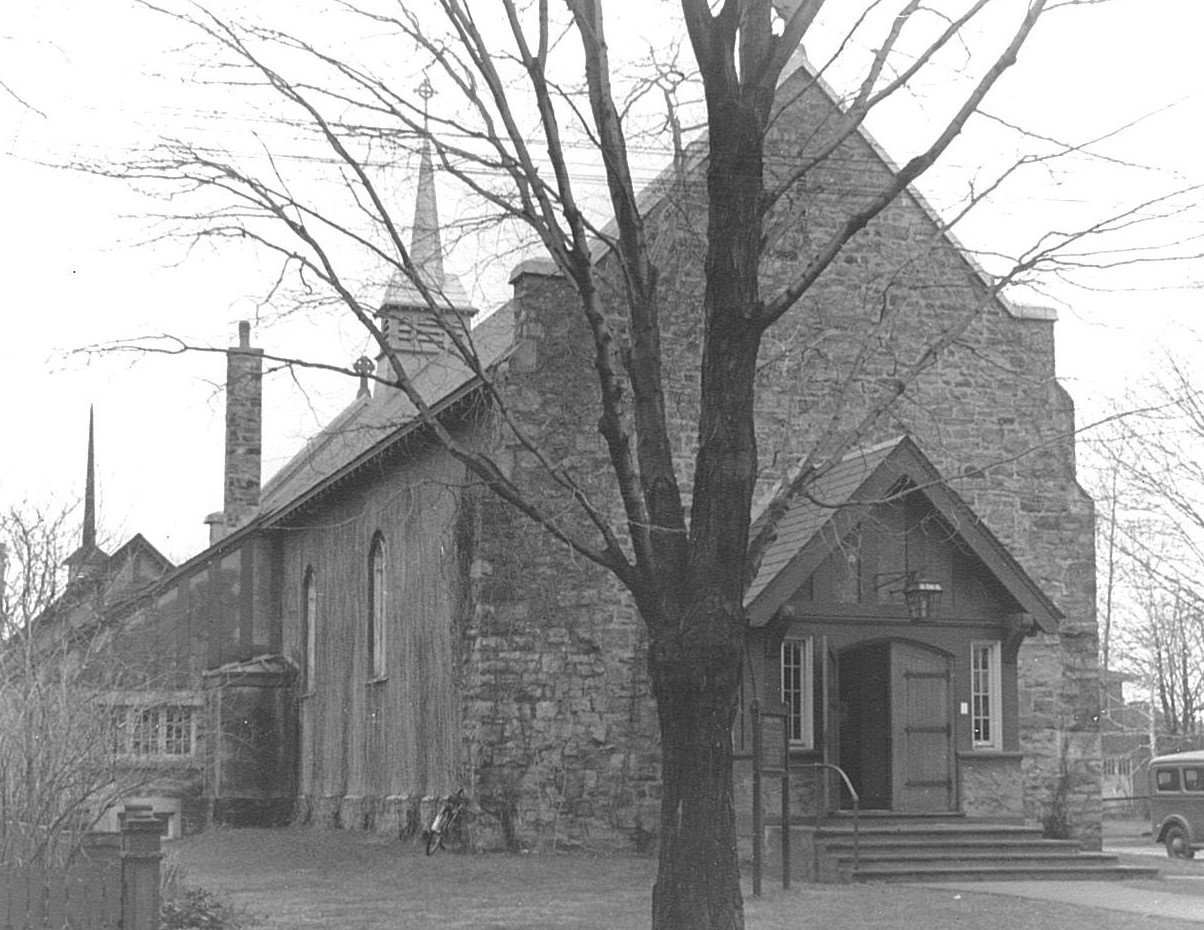
History
By 1896, the Anglican community had grown in Ste-Anne’s to such an extent that the Archbishop of Montreal, Most Rev. Wm. B. Bond, who later became Primate, was asked to provide a resident priest. Rev. John Cattermole, who had been serving the area from Lachine, was appointed and two years later the little church was acquired by the new parish of St. George’s.
St. George’s Church, Ste-Anne-de-Bellevue, had its official beginnings in 1898 when the lot on which it stands today, together with a small clapboard “church” standing on it, were acquired for $150. A small schoolhouse on the lot was also included.
Ste. Anne’s was little more than a summer resort with a few permanent homes and a relatively small congregation, some of whom lived in Senneville. Largely used to host services in the summer, the little church stood amid farmland on the fringe of Ste Anne’s. In 1900, Archbishop Bond consecrated the church in the presence of a large congregation and St. George’s was officially added to the list of churches in the diocese of Montreal.
In 1907 Rev. Cattermole returned to England and was eventually replaced in 1909 by Rev. C.F. Lancaster. Rev. Lancaster came to a larger congregation that that of 1898. MacDonald College had been founded in 1905 and there were now 50 families in the parish. He felt the need for a larger church so in 1910 a church of Gothic design was built on the site of the little frame summer church which had served some 30 years. It was built of stone except for the south wall, which was stuccoed so that in future years it could be readily torn down for enlargement of the church.
A church hall was added in 1920 and the following summer three tennis courts were laid extending from the hall to Perrault Avenue. Rev. Lancaster left the parish in 1923 to become the Director of Religious Education for the Diocese of Massachusetts and was eventually replaced by Rev F.L. Whitely in 1926. A man of wide experience, he was appointed Honorary Canon of Christ Church Cathedral in 1932, which honored St. George’s too, although the parishioners apparently had great difficulty in remembering to address him as Canon.
Canon Whitley took a great interest in the students at Macdonald College and referred to St. George’s as “The Little Church Outside the College Gate”. Two weeks each August the clergy held a conference at the college and on those Sundays the church was full of clergymen as well as students still on campus. Until his retirement, Canon Whitley also served as Chaplain at Ste. Anne’s Veteran’s (then Military) hospital. The strength of the parish was such that during Canon Whitley’s tenure St. George’s acquired its first rectory, at 36 Maple Avenue.
Canon Whitley served 24 years at St. George’s and was succeeded by Rev. John W. Kerr in 1950. When Rev. Kerr came to St. George’s it was still a mission. The population, however, was increasing rapidly and the conviction was growing in the congregation that the parish ought to become self-supporting. This was achieved by 1952 and in 1954 St. George’s gained rectorial status.
However, tragedy struck the next year when fire broke out in the church. The firemen, unable to hook up their hoses immediately due to dense smoke, could only bring the fire under control 3 hours later. The next morning the fire department declared both church and hall an entire loss.
What seemed to be a tragedy turned out to be a triumph. The people rallied to re-build, a campaign dinner was held in the gymnasium of MacDonald High School, chaired by the people’s warden, Fred Ritchie, and attended by the Bishop of Montreal, the mayors of the surrounding towns and over 500 parishioners. Messages were read from the Archbishop of Canterbury and The Primate of Canada. The architect showed slides of the proposed new building. The mayor of Ste. Anne’s, Philip Godin announced a donation of $1,000 from the town council. Other donations came from Union United Church and Temple Emmanuel in Montreal. Union United also offered their church facilities for meetings, weddings, and funerals during the construction and the Roman Catholic Curé supplied bread, wine, and candles. Sunday services were held at MacDonald College where cupboard space was provided for the holy vessels which had escaped the flames. Weekday services were held in parishioners’ homes.
Exactly 2 years after the campaign dinner, the Lord Bishop of Montreal, Bishop John Dixon, dedicated the new St. George’s church. Built of brick, the church seats 400 compared with 180 for the stone church it replaced, and the handful held by the clapboard original.
The church’s design reflects the influence of the liturgical movement. Both ancient and modern materials are combined. The chancel is wide and shallow; the altar is a free-standing table vested in full frontals of the Elizabethan type; the candlesticks are made of teak and stainless steel, as is the communion rail. Near the main door a semi-circular bay forms the baptistry with floor to ceiling windows of stained glass. African, European, Indigenous, and Asians are represented in each of the panels. Under the shell a descending dove depicts the gift of the Holy Spirit.
On Easter Sunday 1969 a magnificent colorful woollen tapestry was installed on the wall behind the altar and dedicated by the Lord Bishop of Montreal, Kenneth Maguire. An anonymous gift from a parishioner in memory of her husband, the tapestry is the work of Mme Mariette Rousseau-Vermette. Its spread of warm color, from gold at the middle, to orange, then red and finally to violet, signifies the spread of the Christian faith.
Under Rev. Asbil’s direction, the small chapel on the right at the front of the church was converted into a church meeting room. Originally named the Chapel of the Good Shepherd, in tribute to the work of former pastors, in its new capacity it was named the Canon Whitley room.
